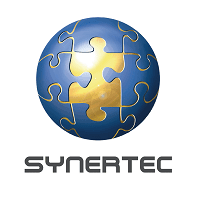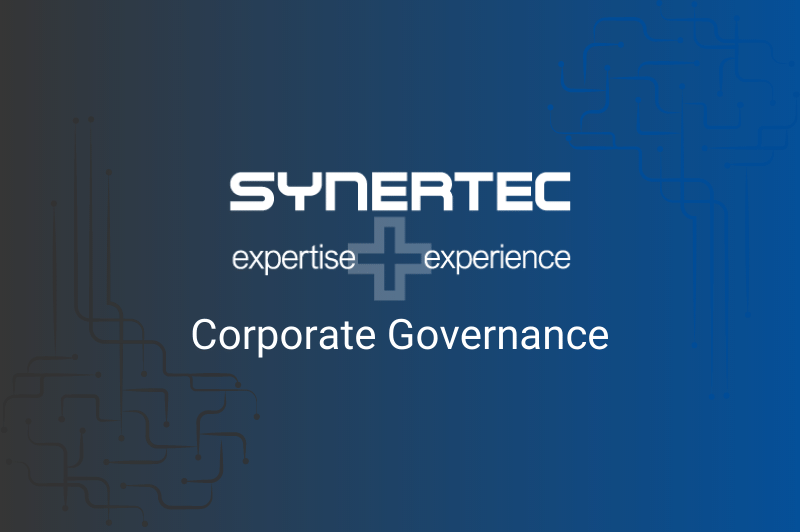SYNERTEC Corporation Limited
ARBN 161 803 032
Role of the Board
The Board of Directors is collectively experienced in engineering consultancy, finance, and the management of listed public companies and the requirements of, and compliance with, the Australian Corporations Act 2001 and ASX Listing
Responsibilities
The Board is responsible for the overall Corporate Governance of the Company and its controlled entities, including monitoring the strategic direction of the Company and its controlled entities, formulating goals for management and monitoring the achievement of those goals.
The Board’s key responsibilities are to:
- establish, monitor and modify the Company’s corporate strategy and performance objectives;
- ensure appropriate corporate governance practices are in place and are operating effectively;
- approve the appointment of an Executive Director and monitor the performance of the
Company’s management; - ensure that appropriate risk management systems, internal control and reporting systems
and compliance frameworks are in place and are operating effectively; - monitor financial results;
- approve and monitor the progress of major capital expenditure, capital management and
acquisitions and divestitures of Company assets; - approve decisions concerning the Company’s capital, including capital restructures, and
dividend policy; - comply with the reporting and other requirements of the Australian Corporations
Board Committees
The Board has established the Audit and Risk Management Committee and the Remuneration and Nomination Committee.
The Board considers the skills and experience of its members allow the committees to act in the best interests of shareholders.
The Board consists of a majority of independent directors and relies upon the skills and experience of both the independent and non-independent directors to act in the best interests of shareholders.
The Board carries out its functions in accordance with statements contained within this charter and the Company’s constitution.
The Company reviews the membership of the committees annually.
Board Structure
In assessing the composition of the Board, Directors have regard for the following guidelines:
- the directors appoint a non-executive director as chairperson of the Board;
- a majority of the Board should comprise non-executive Directors;
- the Board should represent a broad range of qualifications and experience with the right
balance for the ongoing direction of the Company.
The Company has appointed an Executive Director as Managing Director.
The Board is comprised of a minimum of three non-executive Directors. The Board supports the appointment of directors who bring a wide range of business and professional skills and experience to
the Company. The Board is satisfied that it has an effective composition, size, experience and commitment to adequately discharge its responsibilities and duties.
The composition of the Board is reviewed annually to ensure it maintains independence and an effective composition, size, experience and commitment to adequately discharge its responsibilities and duties.
Each director is required to continuously disclose any interest in securities in the company and any other interest which might create a potential conflict of interest with their duties as a director or which would affect their independence.
All Directors are elected by the members at the Annual General Meetings and, thereafter, are subject to election at least once every three years, as required under the Company’s Constitution.
Performance Evaluation
On an annual basis, Directors will provide written feedback in relation to the performance of the Board against a set of agreed criteria.
Feedback will be collected by the chair of the Board and discussed by the Board, with consideration being given as to whether any steps should be taken to improve performance of the Board.
The Board will also obtain feedback from key management personnel in connection with any issues that may be relevant in the context of Board performance review.
Delegations of Authority
In line with good corporate governance, the Board has established general principles under which it and management operate to ensure that business is carried out in the best interests of all stake holders with proper sharing of responsibilities between directors and management.
In performing its duties, the Board takes into account the responsibilities of the Company in meeting specific obligations imposed either as a matter of general law or as a result of regulations relating to a particular business.
The Board has adopted a Delegations of Authority as a register of authorities as delegated by the Board. This document will be maintained in a manner which will provide access to current delegated authorities’ data and which will identify the appropriate staff to authorise particular items.
The Board and management will review the appropriateness of the delegated authorities from time to time or at least annually. Compliance with this policy shall be reviewed regularly to ensure that it is operating effectively.
Audit and Review Function
The Board ensures effective risk management, financial management and compliance management of the Company’s assets. The Board is responsible for the effective discharge of its responsibilities for financial reporting, internal control structures, internal and external audit functions and risk management systems. For the avoidance of doubt this includes environmental matters.
The Board’s functions in this area include:
- review the integrity of the Company’s financial and external reporting;
- review and appraise the internal (where applicable) and external auditors’ activities, scope and independence;
- review and assess the adequacy of management information and internal control structures;
- review and assess the accounting policies of the Company;
- review and report on the annual and half yearly financial reporting carried out by the Company;
- review and assess the sufficiency of and compliance with ethical guidelines and Group policies affecting corporate governance, financial reporting and corporate control, and compliance with laws and external regulations;
- review the adequacy and effectiveness of the Company’s risk management program;
- identify the full range of actual or potential risk exposures which are material to the Company;
- provide assurance that the Company is providing adequate controls against fraud;
- update the Board on changing community standards and recommend changes to Company policy; and
- maintain a list of committee tasks, and ensure compliance with that list on a timely
Risk Management function
The Board of the Company takes a proactive approach to the Company’s risk management and internal compliance and control system.
The Board is responsible for ensuring that risks and mitigation of these risks are identified on a timely basis and that the Company’s objectives and activities are aligned with the risks and opportunities identified by the Board.
The Company continuously undertakes a risk assessment of the Company’s operations, procedures and processes. The risk assessment is aimed at identifying the following:
- a culture of risk control and the minimisation of risk throughout the Company, which is being done through natural or instinctive process by employees of the Company;
- a culture of risk control that can easily identify risks as they arise and amend practices;
- the installation of practices and procedures in all areas of the business that are designed to minimise an event or incident that could have a financial or other effect on the business and its day to day management; and
- adoption of these practices and procedures to minimise many of the standard commercial risks, i.e. taking out the appropriate insurance policies, or ensuring compliance reporting is up to date.



